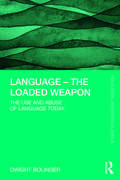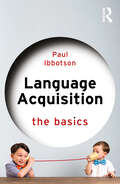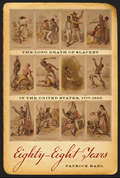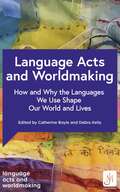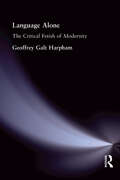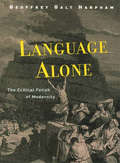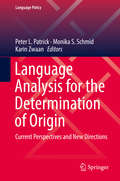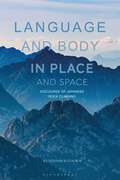- Table View
- List View
Language – The Loaded Weapon: The Use and Abuse of Language Today (Routledge Linguistics Classics)
by Dwight BolingerFirst published in 1980 and now reissued for the first time as a Routledge Linguistics Classic, Language – The Loaded Weapon is at once an introduction to and a critique of everything we know, or think we know, about language. This classic text explains in simple terms the essentials of linguistic form and meaning, and applies them to illuminate questions touching on issues related to: correctness; truth; class and dialect; manipulation through advertising and propaganda; sexual and other discrimination; and official obfuscation and the maintenance of power. Bolinger notes that our deepest societal problems are entangled with language, raising questions such as: What kind of English should be taught, or should there be no standard at all? What are the verbal persuasions of technology doing to our children? Which way does information flow, what are its biases, when does it inform and when conceal, and who benefits? Are the people who consider themselves experts in these matters as expert as they pretend to be? In this seminal work, Bolinger addresses all of these concerns in a way which remains as relevant to us today as it was when it was first written. With a new foreword by James Paul Gee, situating and contextualising the text in the present day, this book is essential reading for anyone with an interest in understanding how language has shaped the world we live in.
Language – The Loaded Weapon: The Use and Abuse of Language Today (Routledge Linguistics Classics)
by Dwight BolingerFirst published in 1980 and now reissued for the first time as a Routledge Linguistics Classic, Language – The Loaded Weapon is at once an introduction to and a critique of everything we know, or think we know, about language. This classic text explains in simple terms the essentials of linguistic form and meaning, and applies them to illuminate questions touching on issues related to: correctness; truth; class and dialect; manipulation through advertising and propaganda; sexual and other discrimination; and official obfuscation and the maintenance of power. Bolinger notes that our deepest societal problems are entangled with language, raising questions such as: What kind of English should be taught, or should there be no standard at all? What are the verbal persuasions of technology doing to our children? Which way does information flow, what are its biases, when does it inform and when conceal, and who benefits? Are the people who consider themselves experts in these matters as expert as they pretend to be? In this seminal work, Bolinger addresses all of these concerns in a way which remains as relevant to us today as it was when it was first written. With a new foreword by James Paul Gee, situating and contextualising the text in the present day, this book is essential reading for anyone with an interest in understanding how language has shaped the world we live in.
Language Acquisition (Palgrave Advances in Language and Linguistics)
by Susan Foster-CohenThis book provides a snapshot of the field of language acquisition at the beginning of the 21st Century. It represents the multiplicity of approaches that characterize the field and provides a review of current topics and debates, as well as addressing some of the connections between sub-fields and possible future directions for research.
Language Acquisition: The Basics (The Basics)
by Paul IbbotsonLanguage Acquisition: The Basics is an accessible introduction to the must-know issues in child language development. Covering key topics drawn from contemporary psychology, linguistics and neuroscience, readers are introduced to fundamental concepts, methods, controversies, and discoveries. It follows the remarkable journey children take; from becoming sensitive to language before birth, to the time they string their first words together; from when they use language playfully, to when they tell stories, hold conversations, and share complex ideas. Using examples from 73 different languages, Ibbotson sets this development in a diverse cross-cultural context, as well as describing the universal psychological foundations that allow language to happen. This book, which includes further reading suggestions in each chapter and a glossary of key terms, is the perfect easy-to-understand introductory text for students, teachers, clinicians or anyone with an interest in language development. Drawing together the latest research on typical, atypical and multilingual development, it is the concise beginner's guide to the field.
Language Acquisition: The Basics (The Basics)
by Paul IbbotsonLanguage Acquisition: The Basics is an accessible introduction to the must-know issues in child language development. Covering key topics drawn from contemporary psychology, linguistics and neuroscience, readers are introduced to fundamental concepts, methods, controversies, and discoveries. It follows the remarkable journey children take; from becoming sensitive to language before birth, to the time they string their first words together; from when they use language playfully, to when they tell stories, hold conversations, and share complex ideas. Using examples from 73 different languages, Ibbotson sets this development in a diverse cross-cultural context, as well as describing the universal psychological foundations that allow language to happen. This book, which includes further reading suggestions in each chapter and a glossary of key terms, is the perfect easy-to-understand introductory text for students, teachers, clinicians or anyone with an interest in language development. Drawing together the latest research on typical, atypical and multilingual development, it is the concise beginner's guide to the field.
Language Acquisition and Academic Writing: Theory and Practice of Effective Writing Instruction
by James D. WilliamsAn important contribution to the scholarship on student writing and composition theory, this book presents a new approach to writing instruction based on linguistic research and theory. In this book, leading scholar James D. Williams explores the historical failures of composition studies and the need for effective writing instruction to be grounded in the immersive principles of language acquisition. Starting with an indictment of the historical failures of composition studies to teach students how to become competent writers, the book moves beyond the current flawed theories and practices to introduce a new way forward to improving students’ writing skills. Accessible and jargon-free, Williams skillfully explains how students must be immersed in target dialects and registers, with access to a range of authentic texts, to become effective writers of academic discourse. Chapters include authentic writing samples from the disciplines, including life and applied sciences, social sciences, and humanities. Essential for preservice and practicing teachers of writing, as well as scholars in composition and literacy studies, the book demonstrates how language acquisition is a necessary foundation and provides a road map to improving students’ writing proficiency.
Language Acquisition and Academic Writing: Theory and Practice of Effective Writing Instruction
by James D. WilliamsAn important contribution to the scholarship on student writing and composition theory, this book presents a new approach to writing instruction based on linguistic research and theory. In this book, leading scholar James D. Williams explores the historical failures of composition studies and the need for effective writing instruction to be grounded in the immersive principles of language acquisition. Starting with an indictment of the historical failures of composition studies to teach students how to become competent writers, the book moves beyond the current flawed theories and practices to introduce a new way forward to improving students’ writing skills. Accessible and jargon-free, Williams skillfully explains how students must be immersed in target dialects and registers, with access to a range of authentic texts, to become effective writers of academic discourse. Chapters include authentic writing samples from the disciplines, including life and applied sciences, social sciences, and humanities. Essential for preservice and practicing teachers of writing, as well as scholars in composition and literacy studies, the book demonstrates how language acquisition is a necessary foundation and provides a road map to improving students’ writing proficiency.
Language Acquisition and Change: A Morphosyntactic Perspective
by Martin Elsig Esther RinkeThis monograph addresses diachronic change of languages in terms of a restructuring of speakers' internal grammatical knowledge. The authors answer questions about the circumstances surrounding grammatical change and attempt to identify causes, constructing a general theory of diachronic change consistent with insights from language acquisition.
Language Acquisition and Language Socialization: Ecological Perspectives (Advances in Applied Linguistics)
by Claire Kramsch'This is an outstanding collection of papers by top scholars in a range of disciplines who shed stimulating, complementary insights into the social, cognitive and semiotic frameworks that shape both the acquisition of language, and the constitution of social actors through that process. The intentionally loose ecological framing of the volume provides an arena within which a range of perspectives, all united by their opposition to a mechanistic view of language acquisition, can enter into dialogue with each other. This is a most stimulating collection, with a range of insightful investigations of settings as diverse as an autistic child learning to interact with others on the playing field, professional gate-keeping encounters, and foreign language classrooms.'Professor Charles Goodwin, University of California at Los AngelesThe book brings together well-known scholars in two relatively distinct fields, language acquisition and language socialization, and from a variety of orientations within applied linguistics to describe language development from a relational perspective. The papers in this volume are a response to three main questions: 1) What conceptual models best capture the ecological nature of language learning? 2) What research approaches are best likely to illuminate the relationship between language and social structure? 3) How is educational success defined for language acquisition and language socialization?
Language Acquisition and Syntactic Theory: A Comparative Analysis of French and English Child Grammars (Studies in Theoretical Psycholinguistics #14)
by A.E. PierceThe theory of language acquisition is a young but increasingly active field. Language Acquisition and Syntactic Theory presents one of the first detailed studies of comparative syntax acquisition. It is informed by the view that linguists and acquisitionists are essentially working on the same problem, that of explaining grammar learnability. The author takes cross-linguistic data from child language as evidence for recent proposals in syntactic theory. Developments in the structure of children's sentences during the first few years of life are traced to changes in the setting of specific grammatical parameters. Some surprising differences between the early child grammars of French and English are uncovered, differences that can only be explained on the basis of subtle distinctions in inflectional structure. This motivates the author's claim that functional or nonthematic categories are represented in the grammars of very young children. The book also explores the relationship between acquisition and diachronic change in French and English. It is argued that findings in acquisition, when viewed from a parameter setting perspective, provide answers to important questions arising in the study of language change. The book promises to be of interest to all those involved in the formal, psychological or historical study of linguistic knowledge.
Language Acquisition and the Multilingual Ideal: Exploring Japanese Language Learning Motivation
by Toshiyuki NakamuraExamining the motivational development of Japanese language learners, this book investigates the relationship between their future self-image as Japanese speakers and their broader self-image as multilingual individuals. The book compares two groups of Japanese language learners, one from Australia and the other from South Korea. Questioning how motivation is influenced both by native languages and by the other languages which learners speak or study, Toshiyuki Nakamura uses dynamic systems theory (DST) to uncover how knowledge of English in these different contexts motivates the learning of Japanese. Employing the concept of 'domain of possible selves' as an analytical framework, the book also provides a detailed description of the development of the learners' visions of themselves as users of Japanese and uncovers various aspects of Japanese language learners' L2 self.
Language Acquisition and the Multilingual Ideal: Exploring Japanese Language Learning Motivation (Bloomsbury Revelations Ser.)
by Toshiyuki NakamuraExamining the motivational development of Japanese language learners, this book investigates the relationship between their future self-image as Japanese speakers and their broader self-image as multilingual individuals. The book compares two groups of Japanese language learners, one from Australia and the other from South Korea. Questioning how motivation is influenced both by native languages and by the other languages which learners speak or study, Toshiyuki Nakamura uses dynamic systems theory (DST) to uncover how knowledge of English in these different contexts motivates the learning of Japanese. Employing the concept of 'domain of possible selves' as an analytical framework, the book also provides a detailed description of the development of the learners' visions of themselves as users of Japanese and uncovers various aspects of Japanese language learners' L2 self.
Language Acquisition and the Theory of Parameters (Studies in Theoretical Psycholinguistics #3)
by Nina HyamsThis book is perhaps the most stunning available demonstration of the explanatory power of the parametric approach to linguistic theory. It is akin, not to a deductive proof, but to the discovery of a footprint in a far-off place which leaves an archeologist elated. The book is full of intricate reasoning, but the stunning aspect is that the reasoning moves between not only complex syntax and diverse languages, but it makes predictions about what two-year-old children will assume about the jumble of linguistic input that confronts them. Those predictions, Hyams shows, are supported by a discriminating analysis of acquisition data in English and Italian. Let us examine the linguistic context for a moment before we discuss her theory. The ultimate issue in linguistic theory is the explanation of how a child can acquire any human language. To capture this fact we must posit an innate mechanism which meets two opposite constraints: it must be broad enough to account for the diversity of human language, and narrow enough so that the child does not make irrelevant hypotheses about his own language, particularly ones from which there is no recovery. That is, a child must not posit a grammar which permits all of the sentences of a language as well as other sentences which are not in the language. In a word, the child must not create a language in which one cannot make adult discriminations between grammatical and ungrammatical.
Language Acquisition (PDF)
by Susan H. Foster-CohenOffers a snapshot of the field of language acquisition at the beginning of the 21st Century. This book represents the multiplicity of approaches that characterize the field and provides a review of different topics and debates.
Language Across Boundaries: Selected Papers From The Annual Meeting Of The British Association For Applied Linguistics Held At Anglia Polytechnic University, Cambridge, September 2000 (British Studies in Applied Linguistics)
by Anne Ife Janet CotterillLanguage across Boundaries is a selection of papers from the millennium conference of the British Association of Applied Linguistics. The thirteen papers are written by applied linguists, from Britain, mainland Europe, the USA, Australia and Singapore, working in a variety of sub-disciplines of the field. The 'boundaries' of the title have been widely interpreted and the book reflects a spectrum of research, ranging from work on the linguistic repercussions of individual and group identity boundaries to work dealing with ways of crossing national and cultural boundaries through language learning and language mediation in the form of translation. Included in the volumes are the plenary papers given by Jennifer Coates, well known for her work on language and gender, on the expression of alternative masculinities; and by Bencie Woll, holder of the first chair of Sign Language and Deaf Studies in the UK, on the insights to be gained from sign language in exploring language, culture and identity.
Language Across the Curriculum & CLIL in English as an Additional Language (EAL) Contexts: Theory and Practice
by Angel M.Y. LinThis book will be of interest to a broad readership, regardless of whether they have a background in sociolinguistics, functional linguistics or genre theories. It presents an accessible “meta-language” (i.e. a language for talking about language) that is workable and usable for teachers and researchers from both language and content backgrounds, thus facilitating collaboration across content and language subject panels. Chapters 1 to 3 lay the theoretical foundation of this common meta-language by critically reviewing, systematically presenting and integrating key theoretical resources for teachers and researchers in this field. In turn, Chapters 4 to 7 focus on issues in pedagogy and assessment, and on school-based approaches to LAC and CLIL, drawing on both research studies and the experiences of front-line teachers and school administrators. Chapter 8 provides a critical and reflexive angle on the field by asking difficult questions regarding how LAC and CLIL are often situated in contexts characterized by inequality of access to the linguistic and cultural capitals, where the local languages of the students are usually neglected or viewed unfavourably in relation to the L2 in mainstream society, and where teachers are usually positioned as recipients of knowledge rather than makers of knowledge. In closing, Chapter 9 reviews the state of the art in the field and proposes directions for future inquiry.
Language Acts and Worldmaking: How and Why the Languages We Use Shape Our World and Our Lives
byCollectively authored by the Language Acts and Worldmaking team, this defining volume offers reflective narratives on research, theory and practice over the course of the flagship project of the same name, funded by the Arts and Humanities Research Council's Open World Research Initiative. It returns to the project's key principles - that our words make worlds and we are agents in worldmaking - analyses the practices and outcomes of collaborative working, and looks to the future by offering concrete ideas for how the work they have done can now continue to do its work in the world.Focusing on the key research strands, this volume looks at the role of the language teacher as a mediator between languages and cultures, worldmaking in modern languages, translation and the imagination, languages and hospitality, digital mediations, and how words change and make worlds. Critically, it analyses the impact on communities of living in multilingual cities, and the ways in which learning a first language, and then a second, and so on, plays a crucial role in our ability to understand our culture in relation to others and to appreciate the ways in which they are intertwined.Specific aims are to: · propose new ways of bridging the gaps between those who teach and research languages and those who learn and use them in everyday contexts from the professional to the personal · put research into the hands of wider audiences · share a philosophy, policy and practice of language teaching and learning which turns research into action · provide the research, experience and data to enable informed debates on current issues and attitudes in language learning, teaching and research · share knowledge across and within all levels and experiences of language learning and teaching · showcase exciting new work that derives from different types of community activity and is of practical relevance to its audiences · disseminate new research in languages that engages with diverse communities of language practitioners.
Language Alone: The Critical Fetish of Modernity
by Geoffrey Galt HarphamHow did the concept of language come to dominate modern intellectual history? In Language Alone, Geoffrey Galt Harpham provides at once the most comprehensive survey and most telling critique of the pervasive role of language in modern thought. He shows how thinkers in such diverse fields as philosophy, psychoanalysis, anthropology, and literary theory have made progress by referring their most difficult theoretical problems to what they presumed were the facts of language.Through a provocative reassessment of major thinkers on the idea of language-Saussure, Wittgenstein, Derrida, Rorty, and Chomsky, among them-and detailed accounts of the discourses of ethics and ideology in particular, Harpham demonstrates a remarkable consensus among intellectuals of the past century and beyond that philosophical and other problems can best be understood as linguistic problems. And furthermore, that a science of language can therefore illuminate them. Conspicuously absent from this consensus, he shows, is any consideration of contemporary linguistics, or any awareness of the growing agreement among linguists that the nature of language as such cannot be known.Ultimately, Harpham argues, the thought of language has dominated modern intellectual history because of its singular capacity to serve as a proxy for a host of concerns, questions, and anxieties-our place in the order of things, our rights and obligations, our nature or essence-that resist a strictly rational formulation. Language Alone will interest literary critics, philosophers, and anyone with an interest in the uses of language in contemporary thought.
Language Alone: The Critical Fetish of Modernity
by Geoffrey Galt HarphamHow did the concept of language come to dominate modern intellectual history? In Language Alone, Geoffrey Galt Harpham provides at once the most comprehensive survey and most telling critique of the pervasive role of language in modern thought. He shows how thinkers in such diverse fields as philosophy, psychoanalysis, anthropology, and literary theory have made progress by referring their most difficult theoretical problems to what they presumed were the facts of language.Through a provocative reassessment of major thinkers on the idea of language-Saussure, Wittgenstein, Derrida, Rorty, and Chomsky, among them-and detailed accounts of the discourses of ethics and ideology in particular, Harpham demonstrates a remarkable consensus among intellectuals of the past century and beyond that philosophical and other problems can best be understood as linguistic problems. And furthermore, that a science of language can therefore illuminate them. Conspicuously absent from this consensus, he shows, is any consideration of contemporary linguistics, or any awareness of the growing agreement among linguists that the nature of language as such cannot be known.Ultimately, Harpham argues, the thought of language has dominated modern intellectual history because of its singular capacity to serve as a proxy for a host of concerns, questions, and anxieties-our place in the order of things, our rights and obligations, our nature or essence-that resist a strictly rational formulation. Language Alone will interest literary critics, philosophers, and anyone with an interest in the uses of language in contemporary thought.
Language Alternation, Language Choice and Language Encounter in International Tertiary Education (Multilingual Education #5)
by Hartmut Haberland, Dorte Lønsmann and Bent PreislerReflecting the increased use of English as lingua franca in today’s university education, this volume maps the interplay and competition between English and other tongues in a learning community that in practice is not only bilingual but multilingual. The volume includes case studies from Japan, Australia, South Africa, Germany, Catalonia, China, Denmark and Sweden, analysing a range of issues such as the conflict between the students’ native languages and English, the reality of parallel teaching in English as well as in the local language, and classrooms that are nominally English-speaking but multilingual in practice. The book assesses the factors common to successful bilingual learners, and provides university administrators, policy makers and teachers around the world with a much-needed commentary on the challenges they face in increasingly multilingual surroundings characterized by a heterogeneous student population. Patterns of language alternation and choice have become increasingly important to the development of an understanding of the internationalisation of higher education that is occurring world-wide. This volume draws on the extensive and varied literature related to the sociolinguistics of globalisation – linguistic ethnography, discourse analysis, language teaching, language and identity, and language planning – as the theoretical bases for the description of the nature of these emerging multilingual communities that are increasingly found in international education. It uses observational data from eleven studies that take into account the macro (societal), meso (university) and micro (participant) levels of language interaction to explicate the range of language encounters – highlighting both successful and problematic interactions and their related language ideologies. Although English is the common lingua franca, the studies in the volume highlight the importance of the multilingual resources available to participants in higher educational institutions that are used to negotiate and solve their language problems. The volume brings to our attention a range of important insights into language issues found in the internationalisation of higher education, and provides a resource for those wishing to understand or do research on how language hybridity and multilingual communicative practices are evolving there. Richard B. Baldauf Jr., Professor, The University of Queensland
Language Analysis for the Determination of Origin: Current Perspectives And New Directions (Language Policy #16)
by Monika S. Schmid Peter L. Patrick Karin ZwaanThis comprehensive, up-to-date volume reports on current practices and use of Language Analysis for the Determination of Origin (LADO). Readers will find chapters on how it is done, where it is used, how it is used, and learn about recent developments on the use of LADO reports in judicial practice, and current controversies in the field. LADO is a highly controversial topic, and a relatively new branch of forensic linguistics that is used by most European and some non-European governments. When asylum seekers cannot submit documentary proof of their origin, their language can be analysed in order to assess whether their linguistic profile is in accordance with their stated origin. Around 10,000 such language analyses take place annually. This volume is based on the series of meetings of the Language and Asylum Research Group held between 2010 and 2012 and convened by the editors, and offers a state-of-the art perspective from researchers, practitioners, policymakers and stakeholders working on or with LADO.
Language and Action: A Structural Model of Behaviour
by David D. ClarkeInternational Series in Experimental Social Psychology, Volume 7: Language and Action: A Structural Model of Behaviour presents studies that tackle human action, relationship between key decisions and outcomes, and the forces that give shape to events. The book particularly focuses on the activity system of conversation. The first chapter provides an introduction to and overview of the structural model of behavior. Chapter 2 reviews several experiments concerning conversation structure. Chapter 3 covers linguistic analogy, while Chapter 4 provides an overview of the structure of discourse. The fifth chapter discusses the theories and models of conversation structure. Chapter 6 tackles the human aspects, while Chapter 7 covers the applications. The eighth chapter presents the conclusion, which includes the evaluation of methods and theoretical issues. The book will be of great interest psychologists, psychiatrists, and other scientists concerned with behavioral structure of conversation.
Language and Being: Heidegger's Linguistics (Bloomsbury Studies in Continental Philosophy)
by Duane WilliamsMartin Heidegger's radical and, for that, controversial reflections on language were not simply a passing interest in his thinking, but a fundamental, career-long concern arguably as significant to him as his study of being. This book traces the intimate connection between language and being in Heidegger's philosophy, and shows how they cannot be understood apart from one another. It discusses why Heidegger's undervalued philosophy of language is increasingly important, how it figures in the wider context of his work, and how it is to be approached and understood for our times. This includes the significance to Heidegger of being, the logos principle, etymology, phenomenology, mysticism, and poetry. Illuminating a difficult yet highly significant area in Heidegger's thinking, Williams provides an insightful and authoritative interpretation of the topic.
Language and Being: Heidegger's Linguistics (Bloomsbury Studies in Continental Philosophy)
by Duane WilliamsMartin Heidegger's radical and, for that, controversial reflections on language were not simply a passing interest in his thinking, but a fundamental, career-long concern arguably as significant to him as his study of being. This book traces the intimate connection between language and being in Heidegger's philosophy, and shows how they cannot be understood apart from one another. It discusses why Heidegger's undervalued philosophy of language is increasingly important, how it figures in the wider context of his work, and how it is to be approached and understood for our times. This includes the significance to Heidegger of being, the logos principle, etymology, phenomenology, mysticism, and poetry. Illuminating a difficult yet highly significant area in Heidegger's thinking, Williams provides an insightful and authoritative interpretation of the topic.
Language and Body in Place and Space: Discourse of Japanese Rock Climbing
by Kuniyoshi KataokaDrawing on the author's experience as a sociolinguist and a mountain climber, this book shows how the expertise and affect-laden experience of Japanese rock climbers can be illuminated through linguistic methods and theories. Through a detailed investigation of multimodal interaction among climbers, the book explores a number of significant sociolinguistic and linguistic anthropological themes, including spatial frames of reference, intersubjectivity, chronotopic configurations, and poetic formations of talk. In doing so, it presents climbing as a condensed locus of human interactions in which the integrated analysis of semiotic processes brings to light a new set of relationships between humans and their surroundings. Grounded in an extended and focused participation in rock climbing activities and interviews with other climbers, Kuniyoshi Kataoka examines the assemblage of semiotic resources including the language, the body, and the space mediated by their climbing equipment and the surrounding environment. The result is a showcase of interdisciplinary multimodal approaches to climbing discourse analysis in and around the gravity-sensitive zone, ranging from expert climbers' instruction to novices, gossip and narratives on near-death experiences, to a multi-participant discussion of a critical accident. As well as demonstrating how language reflects extraordinary experiences on the vertical plane, the findings also offer a chance to learn more about climbing, which is attracting a growing number of participants and competitors worldwide.
